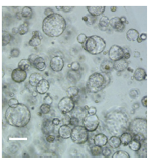Lungs enable us to breathe and are the target of diseases of great public health relevance (e.g., common cold and flu infections, cystic fibrosis, pulmonary fibrosis, and lung cancer amongst others). As of the present, there are virtually no regenerative therapies for lung diseases. As a first step towards future lung regenerative therapies, we have tried to identify lung stem cells with the capability to regenerate both major subdivisions of the lung (the airways and the alveoli). Current lung stem cell populations have been reported to only regenerate either the airways or the alveoli—clearly, a “multipotent” lung stem cell population that could regenerate both the airways and the alveoli would be desirable. We could isolate a new type of multipotent lung stem cell (from mice) with the capacity to regenerate both lung airways and alveoli. In the Petri dish, we could grow these cells for up to 6 months, during which they multiplied extensively, with a single original lung stem cell generating 10e20 (i.e., 100 billion ) lung stem cells over the course of 6 months. Moreover, when these cultured lung stem cells were injected into mouse lungs that were injured with various toxins, the injected lung stem cells regenerated lung tissue in this mouse model of liver injury. In summary, the newfound ability to grow these new mouse multipotent lung stem cells in the Petri dish in very large numbers, and their ability to regenerate both lung airway and alveolar tissue, constitutes a first step towards future lung regenerative therapies. Moreover, these lung stem cells could comprise building blocks to assemble “mini-lung” organoids in the future.
Researchers at Stanford and their colleagues have developed cell culture media, known as LPM-3D, to grow a pure population of multipotent lung stem cells in culture. The lungs are the target of many prevalent diseases but, currently, there are no regenerative therapies for lung disease. One challenge has been obtaining a multipotent stem cell that can generate both lung compartments- the airways (which allow air to pass in and out of the lungs) and the alveoli (which allow gasses to pass in and out of the blood). As a first step toward future lung regenerative therapies, the inventors identified Sox9
+ multipotent stem cells that can generate both airways and alveoli. This technology provides the LPM-3D cell culture media they developed to enable long term expansion of these multipotent lung stem cells. The media was used in a feeder-free, serum-free 3D culture regimen that allowed for rapid proliferation, great expansion and
in vitro culture of the cells for more than 6 months. This technology enables the normally transient Sox9
+ multipotent stem cells to be stably and clonally expanded over the long term in culture.

Image of stem cell colonies after 6 days in culture.
